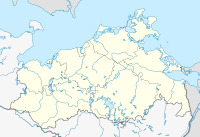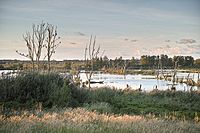Lower Peenetal nature reserve (Peenetalmoor)
Coordinates: 53 ° 52 ′ 7.3 " N , 13 ° 44 ′ 36.3" E
The Lower Peenetal (Peenetalmoor) nature reserve is a 1500 hectare nature reserve in Mecklenburg-Western Pomerania consisting of four sub-areas . It extends over eleven kilometers west, north and east of the city of Anklam alongside the Peene . It was placed under protection on March 1, 1979. The state of the area is assessed as only satisfactory, as the hydrological conditions are disturbed by the adjacent polder areas . There are no public roads in the area.
Sub-areas (from west to east)
- Areas west of the embankment with the Peendammer meadows
- Meadows on federal highway 109 south of Relzow
- central part with the Ferne Wiesen south of the Peene and the Red Moor, the Relzower Bruch and the Kirchwiesen north of the Peene
- Damage island in the estuary to the Peene river
History and water balance
The Peene Valley was created at the end of the last Ice Age as a meltwater runoff from the Haff reservoir to the east . The rise in sea level as part of the Littorina transgression led to permanent flooding of the valley. Extensive bog began. Since the 9th century, the Viking Age trading center Altes Lager near Menzlin has been showing modern settlements not far to the west. The Swedish matriculation card from 1694 shows an almost extensive use of pastures and meadows in today's protected areas. 150 years later, peat cuttings and a close-knit network of ditches for drainage can be seen on the original measuring table sheets. The peat was removed until 1925. From the 1940s onwards, the grassland areas remote from the settlement were left open so that reeds and woody plants could spread. In the mid-1960s, the land use was completely discontinued, except for pipe advertising on the island of Schadefähre. The area has been part of the major nature conservation project Peenetal-Landschaft since the 1990s . Since then, several structural measures have taken place with the aim of rewetting.
Flora and fauna
About two thirds of the areas are designed as flood moor with reed beds , as they are in the flood area of the Peene. The valley edge areas are occupied by flow marshes with sedge-brown moss and wet meadows . Today the peat body reaches a thickness of 0.2 to 8.5 meters. There are meadows of pipe grass with globeflower , broad-leaved and stiff-leaved orchid , splendid carnation , rush edible , swamp blood-eye , scented Mariengrass , meadow elephant , swamp yarrow , large meadow button and piper . The occurrence of a cotton grass meadow sedge is documented on the island of Schadefähre . The nature reserve is known for its endangered butterfly species such as valerian pied butterflies , large meadow birds , mirror spots and large fire butterflies . Furthermore, 345 species of moth were detected. The ground beetle Carabus menetriesi is endemic to the Peene Valley. As breeding birds pipe and harrier , bittern , corncrake , Tüpfelralle , short-eared owl and the red and black kite emphasized. The black-headed gull , common tern , shelduck , shovel and black-necked grebe as well as the limestone species dunlin , curlew , black godwit and redshank are found in the old peat cuttings . The last nationwide occurrences of the reed warbler are proven in the eastern part of the area.
literature
- Lower Peene Valley (Peenetalmoor) 103 . In: Ministry of Environment Mecklenburg-Western Pomerania (Hrsg.): The nature reserves in Mecklenburg-Western Pomerania . Demmler-Verlag, Schwerin 2003, ISBN 3-910150-52-7 , p. 242 f .
Web links
- Interesting facts about the river valley moor of the Peene incl. Photos (page of the association "Naturschutz im Peenetal eV")
- Large-scale nature conservation project Peenetal landscape
- Map portal environment of the State Office for the Environment, Nature Conservation and Geology Mecklenburg-Western Pomerania ( information ) with geodata
- Population development of the Sedge Warbler (PDF) (1.51 MB)




